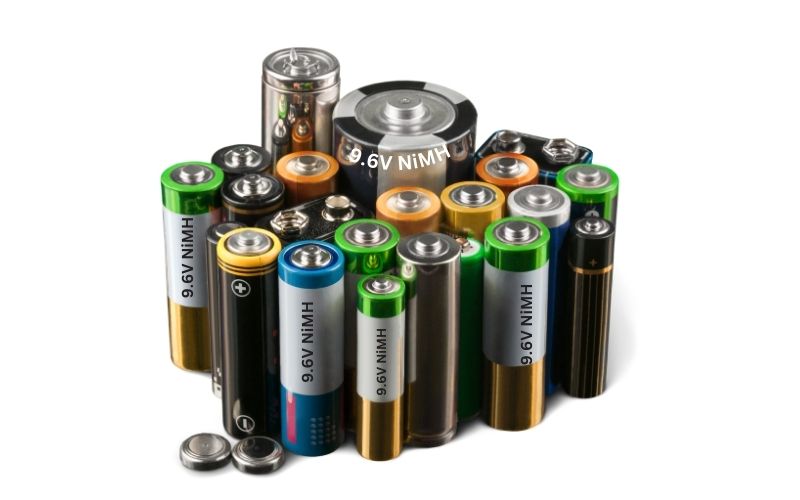Introduction:
Nickel-Metal Hydride (NiMH) batteries have emerged as a popular choice in the rechargeable battery market due to their unique characteristics, improved capacity, and eco-friendliness. In addition, the 9.6V NiMH battery is a common variation, often found in various applications such as remote control toys, cordless power tools, and wireless communication devices.
In this article, we’ll explore the properties, limitations, technical aspects, and uses of the 9.6 Volt Nickel-Metal Hydride (NiMH) battery, providing you with comprehensive knowledge about this versatile energy storage solution.
Properties of 9.6V NiMH Battery:
A 9.6V NiMH backup battery can be made in two different ways. It can be made as a primary cell or secondary cell. Which means it can be manufactured with rechargeable properties or one time charge storage. In both ways, this battery is no-doubt a champion for handy devices.
Rechargeable:
One of the primary advantages of the 9.6V NiMH battery is its ability to be recharged multiple time. Therefore making it a cost-effective and environmentally friendly alternative to disposable batteries.
High Energy Density:
NiMH batteries have a higher energy density compared to their Nickel-Cadmium (NiCd) counterparts, meaning they can store more energy in a given volume or weight, providing longer runtimes for various devices.
Low Self-Discharge Rate:
9.6V NiMH batteries exhibit a lower self-discharge rate compared to NiCd batteries, allowing them to maintain their charge for longer periods when not in use.
Eco-Friendly:
Unlike NiCd batteries, NiMH batteries do not contain toxic heavy metals such as cadmium. Therefore making them a more environmentally friendly option.
Memory Effect:
9.6V NiMH batteries exhibit a minimal memory effect, which means that they can be recharged without being fully discharged, reducing the risk of capacity loss over time.
Technical Properties of 9.6V NiMH Battery:
A 9.6V NiMH Battery is an efficient small backup pack having a reactive metal Ni to provide sufficient charge and power at the same time. Its technical properties are listed as under:
Voltage or potential difference:
The nominal voltage of a 9.6V NiMH battery is typically 9.6 volts, with each of its eight individual cells providing a nominal voltage of 1.2 volts.
Charge Capacity:
The capacity of a 9.6V NiMH battery is measured in milliampere-hours (mAh) or ampere-hours (Ah) and can vary depending on the specific battery model and application. Higher capacity batteries can store more energy, providing extended runtimes for devices.
Discharge Rate (Discharging):
Amazingly, NiMH batteries can support high discharge rates, making them suitable for applications that require a substantial amount of power in a short period, such as power tools or remote control toys.
Limitations of 9.6V NiMH Battery:
Though 9.6V NiMH battery has many advantages for its efficient properties, but it also has limitations listed as following:
Charging Requirements:
NiMH batteries require specific charging techniques and conditions, such as using a compatible charger with a suitable charge rate to prevent overcharging, which can damage the battery and reduce its lifespan.
Sensitivity to Temperature:
Extreme temperatures can adversely affect the performance and longevity of NiMH batteries. They are less efficient in high temperatures and may experience reduced capacity in extremely cold conditions.
Weight:
NiMH batteries are generally heavier than Lithium-ion batteries. However can be a disadvantage in some applications where weight is a critical factor.
Capacity of 9.6V NiMH Battery:
The capacity of a 9.6V NiMH battery varies depending on its design and intended application. Generally, capacities range from a few hundred milliampere-hours (mAh) to several ampere-hours (Ah). Therefore, higher capacity batteries can store more energy, resulting in extended runtimes for devices.
Moreover, when selecting a 9.6V Nickel-Metal Hydride (NiMH) battery, consider the specific power requirements of your application to ensure that the battery provides sufficient capacity and runtime.
A 9.6V NiMH battery can be used in numerous applications and multiple ways. Here’s how you can get most from a 9.6 volt battery.
Remote Control Toys:
The high discharge rate and rechargeable nature of 9.6V NiMH batteries make them a popular choice for powering remote control cars, boats, and airplanes.
Many cordless power tools, such as drills, screwdrivers, and saws, utilize 9.6 volt Nickel-Metal Hydride (NiMH) batteries to provide a balance of power and runtime for various tasks.
Wireless Communication Devices:
Two-way radios, walkie-talkies, and other wireless communication devices often rely on 9.6 volt Nickel-Metal Hydride (NiMH) batteries for their power needs. The rechargeable nature and relatively low self-discharge rate make these batteries suitable for devices that require consistent and reliable power sources.
Emergency Lights:
Emergency lighting systems in commercial and residential buildings can utilize 9.6V NiMH batteries as backup power sources, ensuring that illumination remains available during power outages. You can also learn about emergency light battery replacement.
Backup Power:
The 9.6 volt NiMH battery can be employed as a backup power source in various applications. Such as alarm systems, uninterruptible power supplies (UPS), and other critical systems that demand a reliable and rechargeable energy storage solution.
DIY Projects:
For hobbyists and DIY enthusiasts, 9.6V NiMH batteries can be a versatile and dependable power source for custom electronics projects, robotic creations, or other endeavors that require a rechargeable and high-discharge rate battery.
Conclusion:
The 9.6V NiMH battery is a versatile and eco-friendly rechargeable energy storage solution, offering unique properties that make it suitable for a wide range of applications. Understanding the properties, limitations, technical aspects, and uses of this battery type will enable you to make informed decisions about its suitability for your specific needs.
Always follow the manufacturer’s recommendations for charging, maintenance, and usage. So, to ensure optimal performance and longevity of your 9.6 volt Nickel-Metal Hydride (NiMH)battery.


